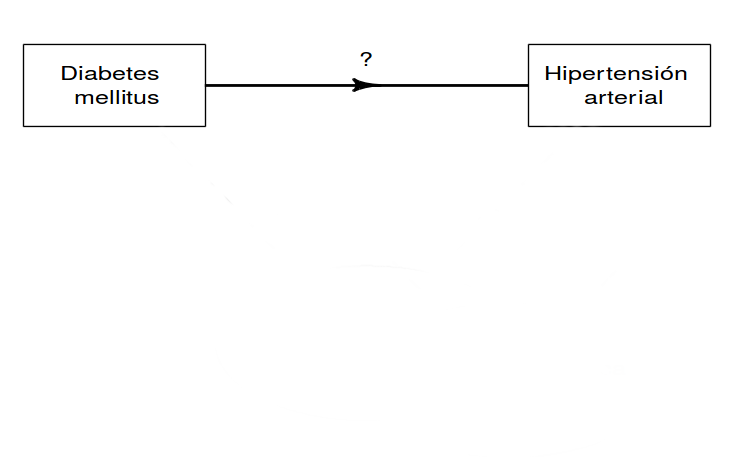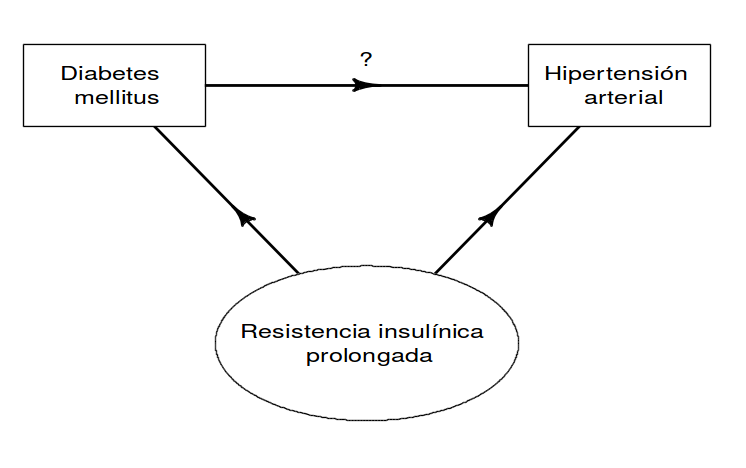ESTUDIOS OBSERVACIONALES: El problema de los factores de confusión.
¿Es la diabetes causa de la hipertensión arterial?

Angelo Santana
Bioestadística. Master SASA. Curso 2023-24
| Variable | All data (n=1030) | DM=No (n=902) | DM=Sí (n=128) | P |
|---|---|---|---|---|
| EDAD | 46.00 (38.00; 56.00) | 44.00 (38.00; 54.00) | 59.50 (53.00; 67.00) | <0.0001 |
| HTA_OMS | <0.0001 | |||
| No | 706 (68.54) | 661 (73.28) | 45 (35.16) | |
| Sí | 324 (31.46) | 241 (26.72) | 83 (64.84) | |
| IR | <0.0001 | |||
| No | 700 (67.96) | 675 (74.83) | 25 (19.53) | |
| Sí | 330 (32.04) | 227 (25.17) | 103 (80.47) |
\[OR=\frac{\Pr\left(\textrm{HTA}\left|DM\right.\right)\left/\Pr\left(\textrm{HTA}^{c}\left|DM\right.\right)\right.}{\Pr\left(\textrm{HTA}\left|{DM}^{c}\right.\right)\left/\Pr\left(\textrm{HTA}^{c}\left|{DM}^{c}\right.\right)\right.}=\frac{1.8409}{0.364}\cong5.058\]
¿Es la diabetes causa de la hipertensión arterial?

¿Es la diabetes causa de la hipertensión arterial?

¿o hay un efecto confusor de la resistencia a la insulina?
¿Cuál es aquí el papel de la edad?
Consideremos un experimento aleatorio en el cuál solo son posibles dos resultados excluyentes; por ejemplo, seleccionar al azar a una persona de una población y determinar si esa persona tiene o no cierta enfermedad .
Sea \(\pi\) la probabilidad de ocurrencia de cierto suceso de interés; por ejemplo, que la persona tenga la enfermedad .
Supongamos que el experimento se repite \(n\) veces en las mismas condiciones, de tal forma que los sucesivos resultados sean independientes; por ejemplo, se evalúan \(n\) personas elegidas al azar en la misma población .
Sea \(X\) = “número de ocurrencias del suceso de interés”; por ejemplo, el número de personas enfermas entre las \(n\) .
\(X\) es, por definición, una variable aleatoria con distribución de probabilidad binomial de parámetros \(n\) y \(\pi\).
Para denotar las variables aleatorias binomiales de parámetros \(n\) y \(\pi\) utilizaremos la notación: \[ X\cong b\left(n,\pi\right) \]
Puede demostrarse que:
\(E\left[X\right]=n\pi\)
\(var\left(X\right)=n\pi\left(1-\pi\right)\)
\(sd\left(X\right)=\sqrt{n\pi\left(1-\pi\right)}\)
La prevalencia estimada de HTA en la población adulta de Telde es del 31.5% (324 casos en una muestra de 1030 personas).
Si se elige una muestra de tamaño \(n\) de esta población y se define la variable aleatoria:
\(X\) = “Número de personas con HTA”
Entonces \(X\cong b\left(n,0.315\right)\).
Sabemos que la HTA se asocia con DM. Esta asociación se traduce en que el parámetro de la distribución binomial cambia según que los sujetos tengan DM o no.
| Variable (levels) | All data (n=1030) | DM = No (n=902) | DM = Sí (n=128) | Chi-Squared test P |
|---|---|---|---|---|
| HTA_OMS | <0.0001 | |||
| No | 706 (68.54) | 661 (73.28) | 45 (35.16) | |
| Sí | 324 (31.46) | 241 (26.72) | 83 (64.84) |
La variable DM determina dos cohortes: cohorte 1 \(\cong\) {DM=Sí} y cohorte 0 \(\cong\) {DM=No}
Si se eligiera una muestra aleatoria de tamaño \(n_i\) en la cohorte \(i\), el número de personas con HTA en esa muestra sería una variable aleatoria binomial de parámetros \(n_i\) y \(\pi\left(i\right)\), \(i=0,1\). Concretamente:
En la cohorte 1 (personas con DM): \(X\cong b\left(n,\pi\left(1\right)=0.6482\right)\).
En la cohorte 0 (personas sin DM): \(X\cong b\left(n,\pi\left(0\right)=0.2672\right)\).
Si consideramos la variable
\[I_{DM}=\begin{cases} 0 & DM=No\\ 1 & DM=Sí \end{cases}\]
El modelo de regresión logística asume que la función \(\pi\left(i\right)\) es de la forma:
\[\pi\left(I_{DM}\right)=Pr\left(HTA\left|I_{DM}\right.\right)=\frac{\exp\left(\beta_{0}+\beta_{1}\cdot I_{DM}\right)}{1+\exp\left(\beta_{0}+\beta_{1}\cdot I_{DM}\right)}\]
En este caso se obtienen: \(\beta_0\) = -1.00896, \(\beta_1\) = 1.62114
De forma que:
\(\pi\left(I_{DM}=1\right)=\frac{\exp\left(-1.00896+1.62114 \right)}{1+\exp\left(-1.00896+1.62114\right)} \approx 0.6484\)
\(\pi\left(I_{DM}=0\right)=\frac{\exp\left(-1.00896 \right)}{1+\exp\left(-1.00896\right)} \approx 0.2672\)
##
## Call:
## glm(formula = HTA_OMS ~ DM, family = binomial, data = telde0)
##
## Deviance Residuals:
## Min 1Q Median 3Q Max
## -1.4459 -0.7885 -0.7885 0.9308 1.6247
##
## Coefficients:
## Estimate Std. Error z value Pr(>|z|)
## (Intercept) -1.00896 0.07525 -13.408 < 2e-16 ***
## DMSí 1.62114 0.19983 8.113 4.96e-16 ***
## ---
## Signif. codes: 0 '***' 0.001 '**' 0.01 '*' 0.05 '.' 0.1 ' ' 1
##
## (Dispersion parameter for binomial family taken to be 1)
##
## Null deviance: 1282.8 on 1029 degrees of freedom
## Residual deviance: 1213.1 on 1028 degrees of freedom
## AIC: 1217.1
##
## Number of Fisher Scoring iterations: 4A partir del modelo \[Pr\left(HTA\left|I_{DM}\right.\right)=\frac{\exp\left(\beta_{0}+\beta_{1}\cdot I_{DM}\right)}{1+\exp\left(\beta_{0}+\beta_{1}\cdot I_{DM}\right)}\]
puede probarse sin mucha dificultad (ver página siguiente) que: \[OR=\frac{\Pr\left(HTA\left|DM\right.\right)\left/\Pr\left(HTA^{c}\left|DM\right.\right)\right.}{\Pr\left(HTA\left|DM^{c}\right.\right)\left/\Pr\left(HTA^{c}\left|DM^{c}\right.\right)\right.}=\exp\left(\beta_{1}\right)=e^{\beta_{1}}\]
En este caso: \[e^{\beta_{1}} = e^{1.62114} = 5.0589\]
\[OR=\frac{\Pr\left(HTA\left|DM\right.\right)\left/\Pr\left(HTA^{c}\left|DM\right.\right)\right.}{\Pr\left(HTA\left|DM^{c}\right.\right)\left/\Pr\left(HTA^{c}\left|DM^{c}\right.\right)\right.}=\]
\[=\frac{\Pr\left(HTA\left|I_{DM}=1\right.\right)\left/\Pr\left(HTA^{c}\left|I_{DM}=1\right.\right)\right.}{\Pr\left(HTA\left|I_{DM}=0\right.\right)\left/\Pr\left(HTA^{c}\left|I_{DM}=0\right.\right)\right.}=\]
\[=\frac{\frac{\exp\left(\beta_{0}+\beta_{1}\right)}{1+\exp\left(\beta_{0}+\beta_{1}\right)}\left/\left(1-\frac{\exp\left(\beta_{0}+\beta_{1}\right)}{1+\exp\left(\beta_{0}+\beta_{1}\right)}\right)\right.}{\frac{\exp\left(\beta_{0}\right)}{1+\exp\left(\beta_{0}\right)}\left/\left(1-\frac{\exp\left(\beta_{0}\right)}{1+\exp\left(\beta_{0}\right)}\right)\right.}=\frac{\exp\left(\beta_{0}+\beta_{1}\right)}{\exp\left(\beta_{0}\right)}=\exp\left(\beta_{1}\right)\]
(hemos tenido en cuenta que \(\Pr\left(HTA^{c}\left|I_{DM}\right.\right)=1-\Pr\left(HTA\left|I_{DM}\right.\right)\))
## (Intercept) DMSí
## 0.3645991 5.0588290
## 2.5 % 97.5 %
## (Intercept) 0.3140499 0.421855
## DMSí 3.4366486 7.534538Cuando consideramos conjuntamente la ocurrencia de Diabetes Mellitus (DM) e InsulinoResistencia (IR), obtenemos la siguiente tabla para los totales y proporciones de hipertensos en el estudio de Telde:
| Variable (levels) | DM_IR = No-No (n=675) | DM_IR = No-Sí (n=227) | DM_IR = Sí-No (n=25) | DM_IR = Sí-Sí (n=103) |
|---|---|---|---|---|
| HTA_OMS | ||||
| No | 539 (79.85) | 122 (53.74) | 11 (44.00) | 34 (33.01) |
| Sí | 136 (20.15) | 105 (46.26) | 14 (56.00) | 69 (66.99) |
| Variable (levels) | All data (n=1030) |
|---|---|
| HTA_OMS | |
| No | 706 (68.54) |
| Sí | 324 (31.46) |
Consideramos ahora que la probabilidad de que un sujeto tenga HTA depende no sólo de la DM sino también de si es o no IR (insulino-resistente): \[\pi\left(I_{DM},I_{IR}\right)=\Pr\left(HTA\left|I_{DM},I_{IR}\right.\right)=\frac{\exp\left(\beta_{0}+\beta_{1}I_{DM}+\beta_{2}I_{IR}\right)}{1+\exp\left(\beta_{0}+\beta_{1}I_{DM}+\beta_{2}I_{IR}\right)}\]
En este caso se obtienen: \(\beta_0\) = -1.34726, \(\beta_1\) = 1.06299, \(\beta_2\) = 1.13921
De forma que:
\(\pi\left(I_{DM}=0, I_{IR}=0\right)=\frac{\exp\left(-1.34726 \right)}{1+\exp\left(-1.34726\right)} \approx 0.2063\,\,\,\,\, \hat{\pi}_{obs}(DM=No,IR=No)=0.2015\)
\(\pi\left(I_{DM}=0,I_{IR}=1\right)=\frac{\exp\left(-1.34726+1.13921 \right)}{1+\exp\left(-1.34726+1.13921\right)} \approx 0.4482\,\,\,\,\, \hat{\pi}_{obs}(DM=No,IR=Si)=0.4626\)
\(\pi\left(I_{DM}=1,I_{IR}=0\right)=\frac{\exp\left(-1.34726+1.06299 \right)}{1+\exp\left(-1.34726+1.06299\right)} \approx 0.4294\,\,\,\,\, \hat{\pi}_{obs}(DM=Si,IR=No)=0.56\)
\(\pi\left(I_{DM}=1,I_{IR}=1\right)=\frac{\exp\left(-1.34726+1.06299 +1.13921 \right)}{1+\exp\left(-1.34726+1.06299 +1.13921 \right)} \approx 0.7016\,\,\,\,\, \hat{\pi}_{obs}(DM=Si,IR=Si)=0.6699\)
##
## Call:
## glm(formula = HTA_OMS ~ DM + IR, family = binomial, data = telde0)
##
## Deviance Residuals:
## Min 1Q Median 3Q Max
## -1.5552 -0.6798 -0.6798 0.8419 1.7767
##
## Coefficients:
## Estimate Std. Error z value Pr(>|z|)
## (Intercept) -1.34726 0.09328 -14.443 < 2e-16 ***
## DMSí 1.06299 0.21625 4.915 8.86e-07 ***
## IRSí 1.13921 0.15430 7.383 1.55e-13 ***
## ---
## Signif. codes: 0 '***' 0.001 '**' 0.01 '*' 0.05 '.' 0.1 ' ' 1
##
## (Dispersion parameter for binomial family taken to be 1)
##
## Null deviance: 1282.8 on 1029 degrees of freedom
## Residual deviance: 1159.2 on 1027 degrees of freedom
## AIC: 1165.2
##
## Number of Fisher Scoring iterations: 4logist <- glm(HTA_OMS~DM+IR,data=telde,family=binomial)
dtf=data.frame(DM=factor(c("No","No","Sí","Sí")),IR=factor(c("No","Sí","No","Sí")))
cbind(dtf,predic=predict(logist,newdata=dtf, type="response"))## DM IR predic
## 1 No No 0.2063183
## 2 No Sí 0.4481725
## 3 Sí No 0.4294062
## 4 Sí Sí 0.7016004## (Intercept) DMSí IRSí
## 0.2599509 2.8950085 3.1242838
## 2.5 % 97.5 %
## (Intercept) 0.2158019 0.3111512
## DMSí 1.9005630 4.4433251
## IRSí 2.3094724 4.2305000En regresión logística multivariante, el efecto de cada variable ha de interpretarse bajo el supuesto de que el resto de variables que intervienen en el modelo no cambian de valor.
Así la OR de 2.895 entre HTA y DM en este modelo significa que:
cuando se comparan dos individuos con IR : el que tenga DM tiene un riesgo 2.895 veces mayor de padecer HTA que el que no tenga DM.
cuando se comparan dos individuos sin IR : el que tenga DM tiene un riesgo 2.895 veces mayor de padecer HTA que el que no tenga DM.
Asimismo la OR de 3.124 entre HTA e IR en este modelo significa que:
cuando se comparan dos individuos con DM : el que tenga IR tiene un riesgo 3.124 veces mayor de padecer HTA que el que no tenga IR.
cuando se comparan dos individuos sin DM : el que tenga IR tiene un riesgo 3.124 veces mayor de padecer HTA que el que no tenga IR.
¿Cuál es el efecto de la edad sobre la probabilidad de padecer HTA? \[\pi\left(\textrm{Edad}\right)=\Pr\left(HTA\left|\textrm{Edad}\right.\right)=\frac{\exp\left(\beta_{0}+\beta_{1}\textrm{Edad}\right)}{1+\exp\left(\beta_{0}+\beta_{1}\textrm{Edad}\right)}\]
En este caso se obtienen: \(\beta_0\) = -4.83149, \(\beta_1\) = 0.08147
La OR entre HTA y Edad es entonces \(e^{\beta_{1}}=e^{0.08147}=1.08488\)
Esta OR representa el incremento (pues es mayor que 1) en el riesgo de padecer hipertensión por cada año adicional que cumple el sujeto.
Podemos calcular el riesgo acumulado en 10 años mediante: \[e^{10 \beta_{1}}=e^{0.8147} = 2.258498 \]
Por tanto, una persona 10 años mayor que otra tiene algo más del doble de riesgo de padecer HTA.
Podemos visualizar el efecto de la edad sobre el riesgo de padecer HTA:
mg <- glm(HTA_OMS ~ EDAD, data=telde, family=binomial)
EDAD=seq(30,80,length=200)
pHTA=predict(mg,newdata=data.frame(EDAD=EDAD),type="response")
plot(pHTA~EDAD, ylab="pr(HTA)", type="l", col="blue",lwd=2)
En este caso: \(\beta_0\) = -4.55068, \(\beta_1\) = 0.90966, \(\beta_2\) = 0.07328
La OR de HTA con DM ajustada por edad es entonces: \[ e^{\beta_1} = e^{0.90966} = 2.48348 \]
A la misma edad padecer DM incrementa en 2.48 veces el riesgo de HTA.
##
## Call:
## glm(formula = HTA_OMS ~ DM + EDAD, family = binomial, data = telde)
##
## Deviance Residuals:
## Min 1Q Median 3Q Max
## -2.1255 -0.7804 -0.5432 0.9044 2.2104
##
## Coefficients:
## Estimate Std. Error z value Pr(>|z|)
## (Intercept) -4.550680 0.348603 -13.054 < 2e-16 ***
## DMSí 0.909660 0.219401 4.146 3.38e-05 ***
## EDAD 0.073285 0.006818 10.748 < 2e-16 ***
## ---
## Signif. codes: 0 '***' 0.001 '**' 0.01 '*' 0.05 '.' 0.1 ' ' 1
##
## (Dispersion parameter for binomial family taken to be 1)
##
## Null deviance: 1282.8 on 1029 degrees of freedom
## Residual deviance: 1081.5 on 1027 degrees of freedom
## AIC: 1087.5
##
## Number of Fisher Scoring iterations: 4## (Intercept) DMSí EDAD
## 0.01056002 2.48347866 1.07603696## Waiting for profiling to be done...## 2.5 % 97.5 %
## (Intercept) 0.005256831 0.02064005
## DMSí 1.619664315 3.83379057
## EDAD 1.061975094 1.09077065Representamos gráficamente la relación entre la probabilidad de padecer HTA y la edad según que el sujeto sea o no diabético:

Por último estudiamos la asociación de DM con HTA ajustando simultáneamente por IR y Edad:
\[\pi\left(I_{DM},I_{IR},\textrm{Edad}\right)=\Pr\left(HTA\left|I_{DM},I_{IR},\textrm{Edad}\right.\right)=\]
\[=\frac{\exp\left(\beta_{0}+\beta_{1}I_{DM}+\beta_{2}I_{IR}+\beta_{3}\textrm{Edad}\right)}{1+\exp\left(\beta_{0}+\beta_{1}I_{DM}+\beta_{2}I_{IR}+\beta_{3}\textrm{Edad}\right)}\]
##
## Call:
## glm(formula = HTA_OMS ~ DM + IR + EDAD, family = binomial, data = telde)
##
## Deviance Residuals:
## Min 1Q Median 3Q Max
## -2.0154 -0.7342 -0.4717 0.8531 2.3655
##
## Coefficients:
## Estimate Std. Error z value Pr(>|z|)
## (Intercept) -4.965598 0.369248 -13.448 < 2e-16 ***
## DMSí 0.323218 0.236159 1.369 0.171
## IRSí 1.178958 0.166337 7.088 1.36e-12 ***
## EDAD 0.074358 0.007001 10.621 < 2e-16 ***
## ---
## Signif. codes: 0 '***' 0.001 '**' 0.01 '*' 0.05 '.' 0.1 ' ' 1
##
## (Dispersion parameter for binomial family taken to be 1)
##
## Null deviance: 1282.8 on 1029 degrees of freedom
## Residual deviance: 1031.2 on 1026 degrees of freedom
## AIC: 1039.2
##
## Number of Fisher Scoring iterations: 4
Resumen de la estimación del modelo:
| Coeficiente (SE) | P | OR (IC-95%) | |
|---|---|---|---|
| (Intercept) | -4.966 (0.369) | < .001 | 0.007 (0.003,0.014) |
| DMSí | 0.323 (0.236) | 0.171 | 1.382 (0.870,2.200) |
| IRSí | 1.179 (0.166) | < .001 | 3.251 (2.349,4.511) |
| EDAD | 0.074 (0.007) | < .001 | 1.077 (1.063,1.092) |